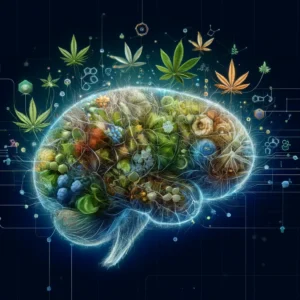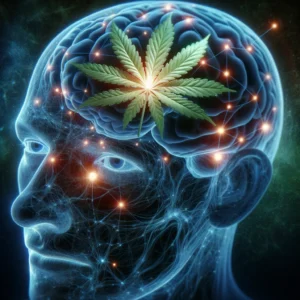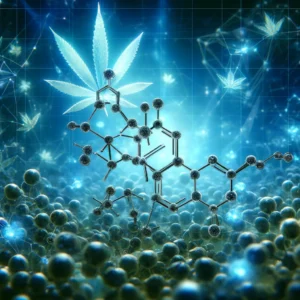The High on Health: A Guide to the Endocannabinoid System
 In the vibrant landscape of biological science, there exists a system that remained shrouded in mystery until recently. This system was only recently brought to light, revealing its critical functions. The endocannabinoid system (ECS) is as fundamental to the human experience as our nervous and immune systems, yet it has long operated quietly in the background. Now, it’s increasingly stepping into the spotlight, capturing both scientific inquiry and public curiosity.
In the vibrant landscape of biological science, there exists a system that remained shrouded in mystery until recently. This system was only recently brought to light, revealing its critical functions. The endocannabinoid system (ECS) is as fundamental to the human experience as our nervous and immune systems, yet it has long operated quietly in the background. Now, it’s increasingly stepping into the spotlight, capturing both scientific inquiry and public curiosity.
Unveiling an Enigmatic System
The story of the ECS is as fascinating as it is newsworthy for the scientific community. Emerging from the shadows of cannabis research, the ECS has captured attention and funding alike, paving the way for a blossoming field of investigations. But what is the ECS, and why is it so significant?
A Discovery that Spans Millennia and Molecules
The history of the ECS traces back to the ancient uses of cannabis as a medicinal herb, with the ECS itself being a comparative newcomer, discovered in the late 1980s and 1990s. Like many scientific breakthroughs, serendipity played a part in this discovery. Israeli researcher, Raphael Mechoulam, widely known as the “father of cannabis research,” and his team put their fingers on the molecular pulse of cannabis and unveiled the previously unknown ECS.
The initial discovery of the ECS components — cannabinoid receptors (CB1 and CB2), endocannabinoids (anandamide and 2-AG), and the enzymes that synthesize and degrade them — was a monumental step. It signaled the beginning of an entirely new era of pharmacological and neurological research.
An Orchestra in Harmony
At the heart of the ECS lie its key components, similar to the various sections of an orchestra.
Cannabinoid Receptors (CB1 and CB2)
Cannabinoid receptors act as the conductor, interpreting the tunes of endocannabinoids and orchestrating the body’s responses. Found throughout the central nervous system, CB1 receptors play a pivotal role in modulating cognition, memory, motor movement, and pain. Conversely, CB2 receptors, predominantly located within the peripheral system, influence immune function and inflammation response.
Endocannabinoids
The endocannabinoids — anandamide, named after the Sanskrit word for “bliss,” and 2-AG — are the molecular musicians, created on-demand in response to cellular “stress” with the aim of maintaining the body’s internal balance, or homeostasis. They perform roles in appetite, memory, and mood, to name a few.
Enzymes
The endocannabinoid orchestra would be a cacophony without the enzymes that fine-tune its performance. Enzymes like fatty acid amide hydrolase (FAAH) and monoacylglycerol lipase (MAGL) shoulder the responsibility of crafting endocannabinoids and clearing them away once their performance is concluded.
ECS at Work
The ECS is a prodigious player in the orchestra of human health, impacting a spectrum of physiological processes:
The Appetite for Knowledge
The ECS’s role in regulating appetite is not only of interest to the medical and nutritional communities but holds broad societal and economic significance as well. With anorexia nervosa, obesity, and metabolic syndromes plaguing our societies, understanding and potentially manipulating the ECS presents significant opportunities for intervention.
Mood, Stress, and the Mind
The ECS’s influence on mood is another area of critical importance. Emerging evidence suggests that the ECS is dysregulated in individuals with mood disorders, offering the potential for new targets in psychiatric treatments.
A Dream with Health Benefits
Sleep, a fundamental human experience, is nochamber of the ECS untouched by its influence. From the regulation of circadian rhythms to the more mysterious and complex nature of dreaming, this system exerts an imperceptible yet discernible influence.
Sharing the Burden of Pain
The ECS’s involvement in the perception of pain stands at the crossroads of human suffering and pain management. It offers a novel and complex system of modulation, ripe with potential for the development of new analgesic strategies.
Guardians of the Mind and Muscles
In the realms of neuroprotection and muscle formation, the ECS plays roles that extend beyond daily function to the very preservation and potential enhancement of mental and physical capabilities.
Keeping Homeostasis in Harmony
Finally, ECS activity ensures that the body maintains internal equilibrium in an environment that is seldom static. It responds to external and internal imbalances, ensuring that the human organism adapts and thrives.
Cannabis and the ECS Dance
The relationship between cannabis and the ECS is a compelling tale of synergy and interaction. Tetrahydrocannabinol (THC), the principal psychoactive component of cannabis, wreaks its “high” by binding to CB1 receptors, mimicking the activities of endocannabinoids and thereby altering physiological and cognitive processes. Cannabidiol (CBD), while not directly binding to these receptors, influences the CS in more indirect and complex ways, offering the tantalizing premise of medicinal applications without the high associated with THC.
The idea of “cannabinoid deficiency,” albeit still a hypothesis, suggests that some diseases may be the result of an inadequate endocannabinoid response. This perspective has kindled hope and further interest in how cannabinoids, either naturally occurring or synthetic, could redress this imbalance and provide therapeutic relief.
The Research Horizon
Ongoing research is now probing the ECS with increasing detail, exploring its multifaceted roles and therapeutic potentials. Understanding how the ECS operates in diverse conditions — from mental health disorders to metabolic diseases — is an exciting but challenging pursuit, given the complexity and variability of human experience.
The translational promise of ECS research is vast. From novel analgesics and mood stabilizers to potential applications in neurodegenerative diseases like Alzheimer’s and Parkinson’s, the future role of the ECS in medicine is a blank canvas waiting for discoveries and artistic representation.
Yet, the path is not without its pitfalls. The complex interplay between the ECS and other physiological systems presents challenges in isolating its effects and understanding the full breadth of its impact. Additionally, the controversial nature of cannabis as a recreational drug has lent certain stigmas to the field, which researchers must navigate with both caution and resolve.
In closing, the story of the endocannabinoid system is one of untapped potential and burgeoning hope. Often, the most significant systems are those that operate silently, yet resolutely, in the background — and in the case of the ECS, its voice is growing louder.
High school students, in particular, stand at a juncture where understanding the ECS and its implications could not only enrich their scientific knowledge but also kindle a deeper appreciation for their own physiological symphony. The ECS revolution beckons, and the future stewards of the scientific community, perhaps you included, are poised to respond to its celestial calling.
The endocannabinoid system, much like the high school student, is a burgeoning system with potential yet to be fully realized. Its mysteries are being uncovered, its implications unraveled, and its role in maintaining the orchestra of human health understood with increasing profundity. Whether you choose to play a part in its ongoing narrative through research, advocacy, or simply informed curiosity, the endocannabinoid system stands as a testament to the power of discovering the unknown within the familiar.









